|
The Woodland Education Centre |
|
|
The Woodland Education Centre |
|
Ecological Survey 2000
Spring Cut Sections (2,
4 and 7)
(Please note, the colour coding given to each section description matches that of the Belt Transect Diagram to aid understanding.) These descriptions build upon the
descriptions of the sections given in the 1999 ecological survey and should be read in
conjunction for maximum benefit. |
Section 2 - Observations 1999 - 2000
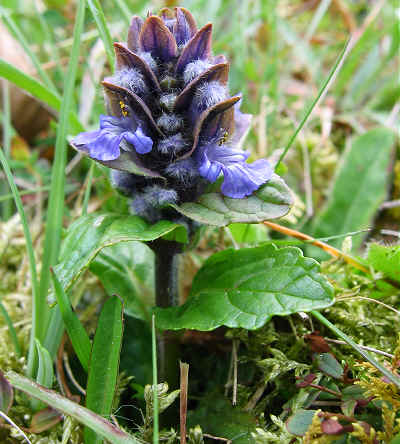 |
Section 2 continued to be dominated by the grasses Yorkshire Fog and
Common Bent. Velvet Bent had decreased substantially in this section. None was recorded in the quadrats sampled this year, whereas half the quadrats sampled in the previous year had contained this grass species. A number of herbs such as Bugle (left), Heath Speedwell and Hedge Woundwort, which had not been present the previous year had spread into this section from neighbouring sections by 2000. |
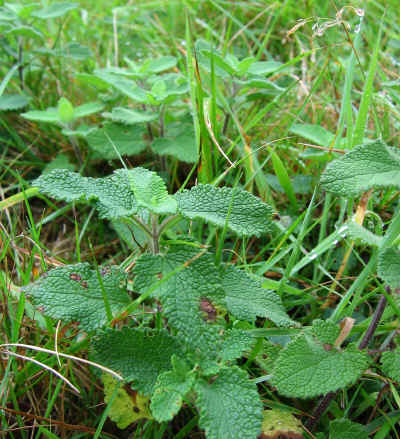 |
Some plants had decreased, especially in section 2, so that they were no longer classed as dominant species in any of the spring cut sections. These included Wood Sage (left), Pill Sedge and Wood Sedge.
|
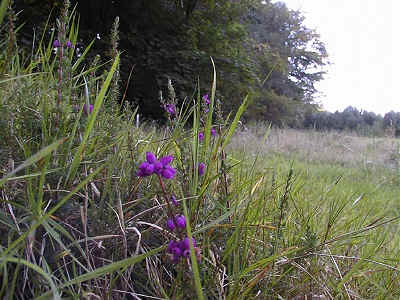 |
The patch of Bell Heather first recorded in section 2 the previous year continued to expand.
|
Section 4 - Observations 1999 - 2000
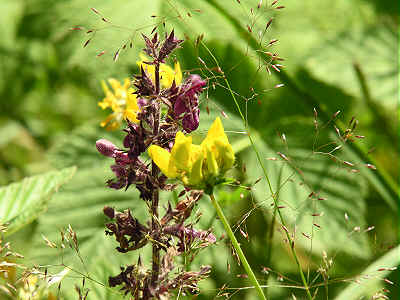 |
While this section was still dominated by grasses, herbs such as Greater
Bird's-foot Trefoil and Hedge
Woundwort (left),
Yellow Pimpernel, Bugle and violet had all increased in abundance in this section over the
year. Greater Bird's-foot Trefoil had doubled in this section, while remaining at a similar low level of abundance in the other spring cut sections. |
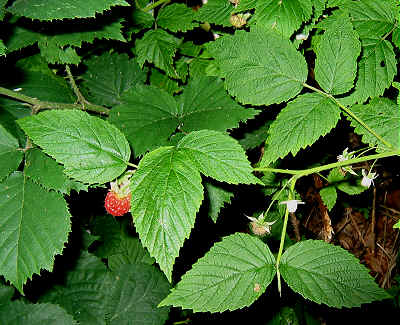 |
Section 4
also contained substantial quantities of Bramble, together with Raspberry (left). Raspberry, which is a plant commonly found on woodland margins, in open woods and on heaths and commons, had not previously been recorded on the project site. Rowan also increased in this section, becoming a dominant species. |
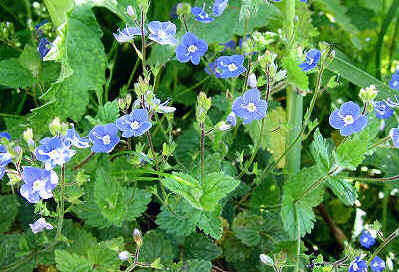 |
Germander Speedwell (left) and Hedge Woundwort were dominant species in this section. |
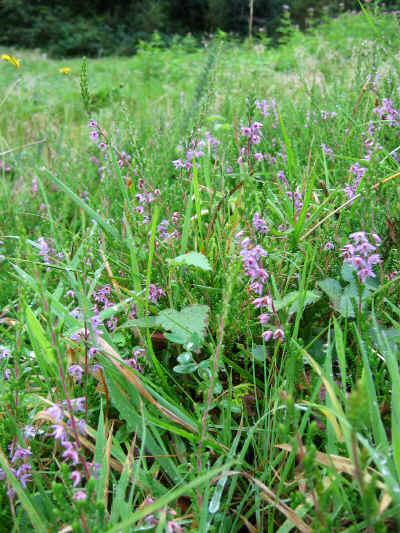 |
Heather (left) and Bell Heather continued to be recorded in this section.
|
Section 7 -
Observations 1999 - 2000
(Spring cut plus initial grass and gorse control)
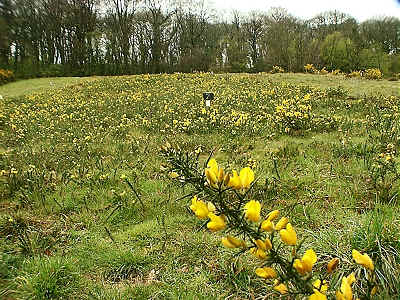 |
The overall dominant species in this section was the moss, Eurhynchium praelongum. Gorse and Common Bent were the two dominant larger plant species in this section. |
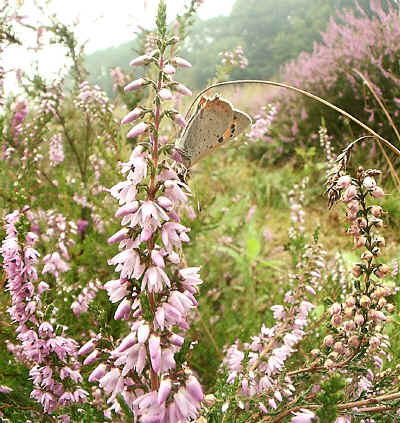 |
The amount of Heather increased substantially in this section, more than doubling its mean % cover over the year.
|
 |
Violets (left) were a dominant species in all the spring cut sections, including section 7, despite the very different overall composition of its vegetation.
|
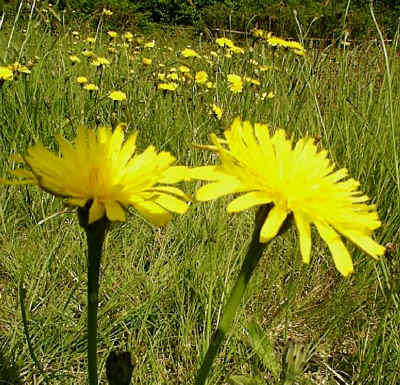 |
Cat's-ear (left) had become a dominant species in this section. This is a perennial species commonly found in pastures, meadows and grassy heaths on mildly acid soils.
|
 |
Cherry (left) had decreased in abundance and was no longer classed as a
dominant species in this section. It was not recorded in the other spring cut sections. |
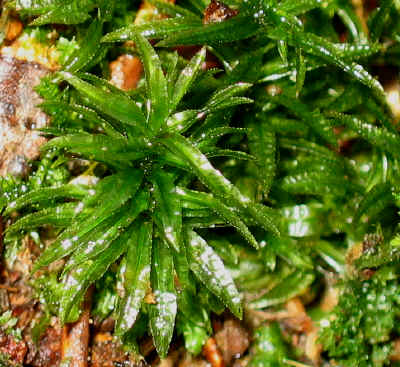 |
The moss,
Atrichum undulatum (left), which had also been a
dominant species in this section in 1999, had decreased substantially. This species,
although more commonly a woodland species, also occurs on heaths and open ground. The amount of Hypnum jutlandicum, another common heathland moss, also halved in section 7, so that it was no longer classed as a dominant species in any of the spring cut sections.
|
Dominant Plants in
Spring Cut Sections in 2000
with figures from 1999 for comparison.
Characteristic heath species
are in bold print
A + sign indicates the species was present, but not recorded in the quadrats.
| Species | Section 2 | Section 4 | Section 7 | |||
| Overall % frequency (mean % cover in brackets) | 2000 | 1999 | 2000 | 1999 | 2000 | 1999 |
| Yorkshire Fog | 100 (52) | 95 (46) | 96 (34) | 100 (54) | 35 (4) | 39 (6) |
| Common Bent | 88 (39) | 85 (42) | 88 (32) | 94 (25) | 74 (16) | 74 (15) |
| Eurhynchium praelongum | 77 (28) | 50 (15) | 46 (6) | 12 (2) | 78 (29) | 74 (33) |
| Thuidium tamarascinum | 45 (21) | 40 (15) | 9 (2) | 0 | 62 (19) | 52 (25) |
| Common Dog-violet | 41 (3) | 35 (3) | 100 (21) | 76 (21) | 39 (3) | 43 (4) |
| Polytrichum formosum | 38 (17) | 50 (19) | 13 (5) | 24 (3) | 65 (26) | 70 (31) |
| Yellow Pimpernel | 27 (3) | 20 (4) | 75 (11) | 59 (9) | 7 (0.1) | 9 (1) |
| Bramble | 25 (2) | 50 (6) | 63 (6) | 65 (8) | 58 (8) | 43 (7) |
| Field Woodrush | 19 (1) | 15 (3) | 9 (1) | 0 | 51 (6) | 0 |
| Smooth-stalked Sedge | 15 (3) | 15 (3) | 13 (2) | 12 (2) | 52 (15) | 48 (19) |
| Hypnum jutlandicum | 13 (3) | 15 (7) | 9 (0.4) | 0 | 13 (3) | 26 (2) |
| Green-ribbed Sedge | 13 (1) | 0 | 25 (5) | 0 | 7 (0.5) | 35 (9) |
| Slender St. John's-wort | 11 (0.2) | 5 (0.3) | 9 (0.2) | 18 (0.5) | 27 (2) | 17 (1) |
| European Gorse | 9 (0.3) | 10 (2) | 25 (3) | 6 (3) | 72 (22) | 74 (34) |
| Heath Speedwell | 7 (0.1) | 0 | 17 (2) | 12 (2) | 30 (2) | 30 (3) |
| Compact Rush | 4 (0.5) | 15 (1) | 42 (3) | 41 (4) | 68 (4) | 52 (5) |
| Silver Birch | 4 (0.2) | 0 | 33 (2) | 18 (2) | 45 (5) | 52 (6) |
| Bugle | 4 (0.5) | 0 | 71 (10) | 59 (11) | 0 | 4 (0.5) |
| Hedge Woundwort | 4 (1) | 0 | 33 (4) | 35 (6) | 0 | 0 |
| Velvet Bent | 0 | 50 (13) | 4 (4) | 12 (3) | 23 (6) | 0 (0) |
| Rowan | 0 | 10 (0.5) | 29 (2) | 12 (0.2) | 10 (0.1) | 0 |
| Raspberry | 0 | 0 | 29 (3) | 0 | 4 (0.5) | 0 |
| Pill Sedge | 0 | 30 (5) | 4 ( | 12 (1) | 17 (2) | 17 (2) |
| Heath Woodrush | 0 | 15 (2) | 9 (0.5) | 6 (0.5) | 30 (3) | 48 (10) |
| Greater Bird's-foot Trefoil | 0 | + | 50 (7) | 29 (2) | 7 (1) | 9 (0.5) |
| Germander Speedwell | 0 | 0 | 25 (1) | 18 (3) | 0 | 0 |
| Heather | 0 | 0 | 4 (1) | + | 45 (24) | 35 (9) |
| Cat's-ear | 0 | 0 | 0 | 0 | 23 (3) | 9 (0.3) |
| Percentage frequency = the percentage of the total number of quadrats sampled over the whole site which contain the species. For example, a percentage frequency of 100%, means that the species was found in all quadrats sampled. |
>> Continue to Autumn Cut Sections
Ecological Survey 2000 |